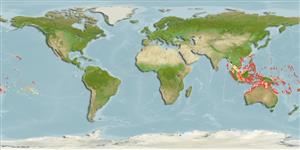>
Gobiiformes (Gobies) >
Gobiidae (Gobies) > Gobiinae
Etymology: Eviota: No etymology given, suggested by Christopher Scharpt: from Latin 'eu' for 'true' and 'iota' for anything very small, in combination 'truly very small' referring to it as being the smallest vertebrate at the time it has benn described by Jenkins (thus, making the suggestion by Scharpt plausible..
More on authors: Lachner & Karnella.
Environment: milieu / climate zone / depth range / distribution range
Écologie
marin récifal; profondeur ? - 44 m (Ref. 86942). Tropical; 25°N - 24°S
Western Pacific: Australia. Records from other areas may represent different species, from Cocos-Keeling Islands throughout the East Indies; in the south from Bali eastwards to Samoa and New Caledonia and southward to Australia (Scott Reef and the southern Great Barrier Reef); in the north extending to the Yaeyama Islands of Japan and eastward to Micronesia (Palau, FSM - Truk and Enewetak, and the Marshall Islands). Records from Fiji refers to Eviota karaspila.
Taille / Poids / Âge
Maturity: Lm ? range ? - ? cm
Max length : 3.0 cm SL mâle / non sexé; (Ref. 48637)
Description synthétique
Clés d'identification | Morphologie | Morphométrie
Épines dorsales (Total) : 5 - 7; Rayons mous dorsaux (Total) : 8 - 10; Épines anales: 1; Rayons mous anaux: 8 - 9. Characterized by semi-transparent body with red-brown internal bars; irregular reddish blotches on nape; presence of intense black spot above gill opening; three red blotches separated by white or yellow bars on side of belly; base of pectoral fin with narrow white band; longitudinal scale series 23-25; ctenoid scales, absent on head and breast; separated pelvic fins, thin membrane joining bases; depth of body 6.5-7.7 in SL (Ref. 90102). Dorsal to anal fin-ray formula 9/8 (Ref. 116739).
Found on rocks of corals reefs in the infralittoral zone (Ref. 559, 48637). Solitary or in groups, resting at bottom (Ref 90102). Spawning appears to be repeated on a regular cycle, semilunar or every 14 days (Ref. 116739).
Life cycle and mating behavior
Maturities | Reproduction | Spawnings | Egg(s) | Fecundities | Larves
Myers, R.F., 1991. Micronesian reef fishes. Second Ed. Coral Graphics, Barrigada, Guam. 298 p. (Ref. 1602)
Statut dans la liste rouge de l'IUCN (Ref. 130435)
Menace pour l'homme
Harmless
Utilisations par l'homme
Outils
Articles particuliers
Télécharger en XML
Sources Internet
Estimates based on models
Preferred temperature (Ref.
123201): 25.4 - 28.9, mean 27.9 °C (based on 524 cells).
Phylogenetic diversity index (Ref.
82804): PD
50 = 0.5000 [Uniqueness, from 0.5 = low to 2.0 = high].
Bayesian length-weight: a=0.00708 (0.00333 - 0.01504), b=3.09 (2.92 - 3.26), in cm total length, based on LWR estimates for this (Sub)family-body shape (Ref.
93245).
Niveau trophique (Ref.
69278): 3.1 ±0.3 se; based on size and trophs of closest relatives
Generation time: 0.1 ( na - na) years. Estimated as median ln(3)/K based on 1
growth studies.
Résilience (Ref.
120179): Haut, temps minimum de doublement de population inférieur à 15 mois (Preliminary K or Fecundity.).
Fishing Vulnerability (Ref.
59153): Low vulnerability (10 of 100).
Nutrients (Ref.
124155): Calcium = 1330 [158, 29,821] mg/100g; Iron = 9.6 [1.1, 60.1] mg/100g; Protein = 17.4 [13.4, 21.2] %; Omega3 = 0.0782 [, ] g/100g; Selenium = 476 [12, 13,279] μg/100g; VitaminA = 3.15 [0.03, 248.84] μg/100g; Zinc = 21.9 [3.7, 83.0] mg/100g (wet weight);
